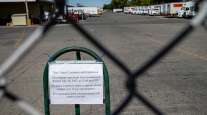Tight Truckload Capacity May Boost Slow-Moving LTL Recovery
This story appears in the Aug. 9 print edition of Transport Topics.
Second-quarter earnings reports from the less-than-truckload sector show a tepid recovery compared with truckload companies, although executives said tightening truckload supply could divert freight into LTL terminals.
The LTL improvement has been uneven, with some firms showing themselves on strong footing, more carriers turning year-ago losses into slender profits and others narrowing losses.
“LTL is a bit of a laggard on pricing. There’s still too much capacity in the industry, so we’re seeing some tough pricing for companies,” Jack Holmes, president of UPS Freight, said in a July 27 interview in Transport Topics’ offices.
YRC Worldwide Inc., the nation’s largest LTL, decreased its quarterly loss substantially from
a year ago to $10.3 million, or 1 cent a share, from $309 million, or $5.20 a share, a year earlier. Quarterly revenue dipped to 1.12 billion from $1.23 billion in the second quarter of last year.
“We are pleased with the sequential improvement in our business volumes and earnings as our pricing discipline, customer mix management and cost initiatives gain significant traction,” YRC Worldwide Chairman and CEO William Zollars said in the corporation’s Aug. 3 earnings statement.
As to the performance of its two major LTL operating sectors, longhaul and regional, the company provided two presentations.
Using Generally Accepted Accounting Principles, YRC said operating ratios for the longhaul and regional divisions and the corporation as a whole were all below 96 for the quarter, whereas a year ago they had all been 114 or more. Only the smaller truckload division remained above 100 — at 107 — using GAAP.
Operating ratio measures expenses as a percentage of revenue.
YRC also gave an adjusted cash-flow presentation to include fees for letters of credit, equity-based compensation, the discontinued YRC Logistics division and financial covenants.
The alternative method still shows YRC Regional with a 98.7 OR, down from 114.6 last year, but YRC National had a 104.6 operating ratio, improved from 128.3 in 2009, and the consolidated OR improved, year-over-year, to 103.2 from 124.6.
UPS’ Holmes, who has run the nation’s fourth-largest LTL carrier since 2007, said thrifty shippers bundled their LTL shipments into truckload lots during the recession as a tactic for saving money. Now, though, that plan is bumping up against a changing market.
“As the truckload market tightens, truckload freight that was once LTL freight is coming back to us,” Holmes said.
“Our freight volumes have picked up,” said Billy Hupp, chief operating officer of Estes Express Lines. The privately held Richmond, Va., carrier benefited from an unusual freight pattern, he said.
“June and July were steady, and usually we see a slip of, maybe, up to 4%. However, they were better than expected, and that was a welcome surprise,” he said.
Hupp also said his average weight per shipment has been on the rise, and he expects that is from shippers who originally had planned to move truckload but changed.
Truckload shipping often leads the path for LTL, both into a recession and out of it, said Bob Costello, chief economist of American Trucking Associations.
“That’s been the typical pattern,” he said, adding that his research shows the number of LTL shipments hit bottom in February and then rose 4.6% through May. Less-than-truckload tonnage fell to its lowest in December, he said, and rose 5%, also through May.
Among public companies, Old Dominion Freight Line had the best quarterly operating ratio, driving the figure to 89.1 from 93.2 a year ago.
ODFL net income doubled to $21.5 million from $10.7 million in the 2009 quarter, as its quarterly revenue rose 16.5%, year-over-year, to $368.2 million. Total tonnage hauled rose 13.4%, but pricing was soft.
Old Dominion said its revenue per hundredweight, or yield, rose 3% with fuel surcharges but contracted by 1.1% without them.
Estes’ Hupp said LTL pricing was worst during the second half of last year.
“It went from ridiculous to brutal,” he said, characterizing the current market as “rational,” although not yet good.
Among the results from other public LTL carriers:
n Quarterly net income at Con-way Inc. fell to $13.9 million, or 26 cents a share, from $31.5 million, or 64 cents a share, in the second quarter last year. Revenue rose to $1.31 billion from $1.06 billion.
Con-way’s LTL unit also generated more revenue and hauled more tonnage than a year ago, but quarterly operating income fell to $17.2 million from $49 million.
• Roadrunner Transportation Systems had a net loss of $6.38 million, or 25 cents a share, compared with a profit of $381,000, or 2 cents a share, a year ago. Quarterly revenue rose to $159.8 million from $120.2 million.
RRTS went through unique circumstances in May, going public and acquiring Group Transportation Services Holdings. In discussing its core LTL business, the company said operating ratio improved and tonnage and pricing increased.
• Saia Inc. turned a loss last year into a profit, earning $1.98 million, or 12 cents a share, compared with a loss of $1.75 million, or 13 cents a share, a year ago. Revenue rose to $231.3 million from $218.4 million.




